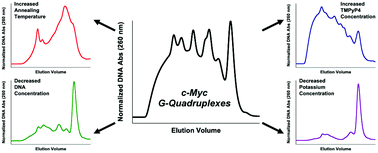G-quadruplexes, DNA tertiary structures highly localized to functionally important sites within the human genome, have emerged as important new drug targets. The putative G-quadruplex-forming sequence (Pu27) in the NHE-III1 promoter region of the c-Myc gene is of particular interest as stabilization of this G-quadruplex with TMPyP4 has been shown to repress c-Myc transcription. In this study, we examine the Pu27 G-quadruplex-forming sequence and its interaction with TMPyP4. We report that the Pu27 sequence exists as a heterogeneous mixture of monomeric and higher-order G-quadruplex species in vitro and that this mixture can be partially resolved by size exclusion chromatography (SEC) separation. Within this ensemble of configurations, the equilibrium can be altered by modifying the buffer composition, annealing procedure, and dialysis protocol thereby affecting the distribution of G-quadruplex species formed. TMPyP4 was found to bind preferentially to higher-order G-quadruplex species suggesting the possibility of stabilization of the junctions of the c-Myc G-quadruplex multimers by porphyrin end-stacking. We also examined four modified c-Myc sequences that have been previously reported and found a narrower distribution of G-quadruplex configurations compared to the parent Pu27 sequence. We could not definitively conclude whether these G-quadruplex structures were selected from the original ensemble or if they are new G-quadruplex structures. Since these sequences differ considerably from the wild-type promoter sequence, it is unclear whether their structures have any actual biological relevance. Additional studies are needed to examine how the polymorphic nature of G-quadruplexes affects the interpretation of in vitro data for c-Myc and other G-quadruplexes. The findings reported here demonstrate that experimental conditions contribute significantly to G-quadruplex formation and should be carefully considered, controlled, and reported in detail.

You have access to this article
 Please wait while we load your content...
Something went wrong. Try again?
Please wait while we load your content...
Something went wrong. Try again?


 Please wait while we load your content...
Please wait while we load your content...